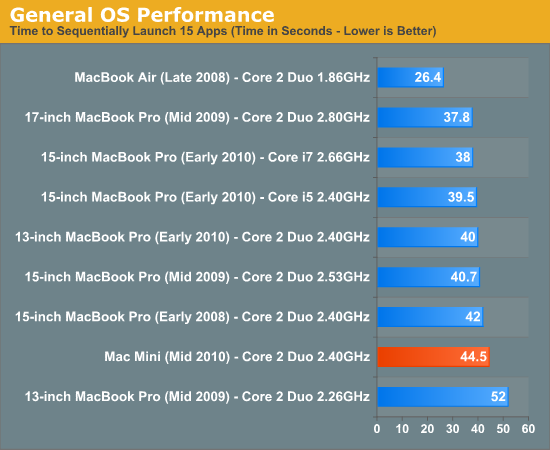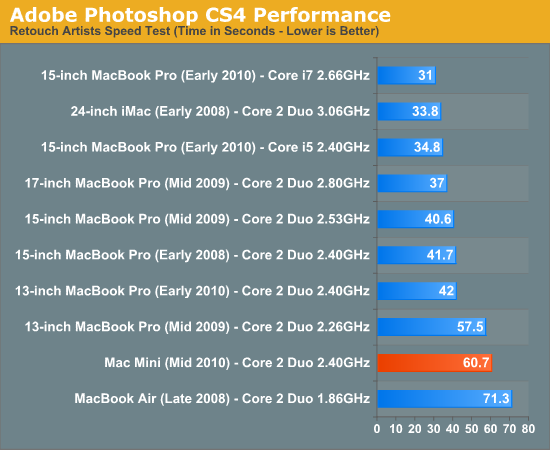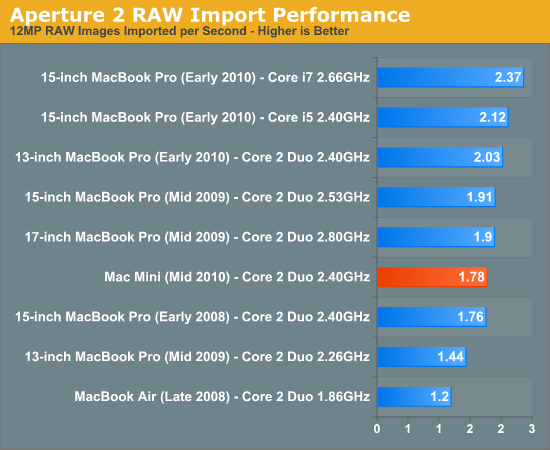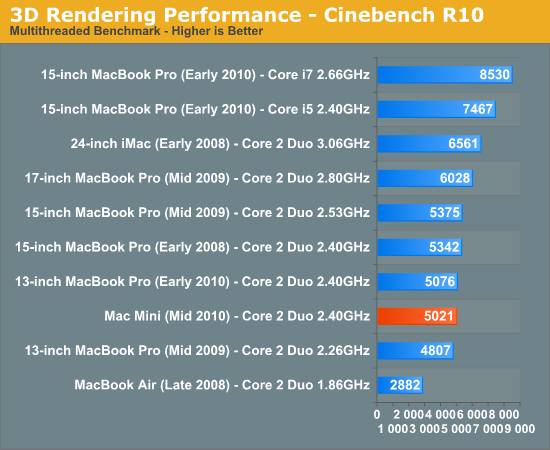Apple Mac mini Review (Mid 2010)
by Anand Lal Shimpi on August 9, 2010 3:37 AM ESTGeneral Performance
The original Mac mini was fast enough for the entry level Mac user back in 2005. Given that Apple’s iPad is fast enough for many users today, I don’t think it’s too difficult to understand that the 2010 Mac mini is sufficient for most needs.
There are two problems with the overall performance of the mini that will contribute to it feeling slow, particularly over time. The first is memory, and I’ll touch on this in more detail later, but 2GB of RAM is simply not sufficient for a computer running a heavyweight OS. Even light multitasking exposes this weakness. The second is the hard drive.
Apple ships the Mac mini with a 2.5” 5400RPM notebook drive. The drive keeps power consumption and noise down to a minimum, while being awful for performance. To Apple’s credit, OS X does a good job of caching frequently used data but without enough RAM this is a wobbly crutch.
The Mac mini is absolutely begging to have an SSD, and unlike the rest of Apple’s Mac lineup, one isn’t even offered on the mini. I’m going to take this opportunity to again plead for Apple to include a decent SSD in its customization options. These days the name of the game is SandForce. While that may change in another quarter or two, we still need Apple to take SSDs more seriously than it has been.
Now on to the numbers. I didn't have any previous generation Intel Mac minis on hand so the performance comparison is mainly to the MacBook/MacBook Pro. I did throw in some results from the early 2008 iMac I reviewed a while back.
General OS Performance
General OS usage is a difficult thing to quantify, but one measure of performance has always been the number of bounces an icon in the dock makes before an application loads. I decided to take it to the next level and write a quick script to launch 15 applications in a row, timing how long the entire process takes.
I launched, in order: Mail, Safari, Activity Monitor, iTunes, iCal, DVD Player, iPhoto, Photo Booth, Quicktime Player, Disk Utility, Preview, iMovie, Front Row, Garage Band and Aperture.
The entire process stresses both the disk and CPU, which is why we see a huge improvement when going to an SSD as well as differences between CPU speeds.

Application launch performance is slower than the 13-inch MacBook Pro because of the mini’s 2GB of memory. You’ll see this trend continuing as we go through our tests.
Adobe Photoshop CS4 Performance
The Retouch Artists Speed Test we use for our CPU testing under Windows also works under OS X. We're running the exact same benchmark here, basically performing a bunch of image manipulations and filters and timing the entire process.

Photoshop performance is decent, but again behind the latest MBPs because we’re swapping to disk. Not only does the mini ship with 2GB of memory but it has to share 256MB with the GeForce 320M.
Aperture 2 RAW Import
For my Aperture test I simply timed how long it took to import 203 12MP RAW images into the library.

Our Aperture test is heavier on the I/O and thus narrows the gap between the 13-inch MBP and the mini.
Cinebench R10
I’m a fan of the Cinebench test because it lets me show off both single and multithreaded performance in the same workload. First, the single threaded performance:


If we’re totally CPU bound, which is the case with Cinebench, you’ll see that the mini performs no differently than the 13-inch MacBook Pro. Compared to a mobile Core i5 you’re looking at roughly 70% of the performance. It’s fast enough, but not speedy.
Quicktime H.264 Video Encoding
Our final benchmark is more consumer focused. Here I'm taking an XviD and converting it to an iPhone-supported H.264 format.

Video encoding performance is once again where we’d expect it to be, roughly on par with the 13-inch MacBook Pro. The new i5 systems are 60% faster.
Maintaining Profit Margins: 2GB vs. 4GB RAM
The $699 mini is the only Mac that currently ships with less than 4GB of memory (except for the MacBook Air). For a $700 system, that’s unacceptable. For a machine that’s sold in 2010, that’s unacceptable. For something that’s not a nettop, well, you get the idea.
The performance gain you see from just adding another 2GB of memory to the 2010 mini is huge. Here’s our Photoshop benchmark before and after an upgrade to 4GB:
| 2010 Mac mini Performance | ||||
| 2GB RAM | 4GB RAM | |||
| Photoshop CS4 Retouch Artists Bench | 60.7 seconds | 42.1 seconds | ||
| Cinebench R11.5 CPU | 1.38 points | 1.39 points | ||
That’s a 44% performance increase! The Cinebench results don't show a similar performance improvement since we're fully CPU bound in an test that easily fits in main memory.
You can argue that not all Mac mini owners won’t be running Photoshop, and I’d even agree with you there, but the memory limits come into play as soon as you start running a couple of large footprint applications. The multitasking falloff is sharp on the Mac mini because you only have 2GB of memory and you’ve got a dirt slow 5400RPM notebook hard drive in there.
The Photoshop results are just to show you something quantifiable. The user experience of the Mac mini is noticeably diminished by only having 2GB of memory.
Upgrading the memory is pretty simple. Just twist the pedestal on the bottom, remove the cover and swap sticks:
Apple ships the mini with 2 x 1GB sticks and the GeForce 320M has a dual-channel DDR3 memory controller so you’ll want to upgrade in pairs as well. Apple charges $100 for the upgrade, which isn’t too bad but you’re better off buying the memory yourself and just eBaying what you get with the system.
You just need to buy DDR3-1066 SO-DIMMs, the same thing you’d put in a notebook.










93 Comments
View All Comments
CharonPDX - Monday, August 9, 2010 - link
People talk about how Apple is incapable of switching to the i3/i5/i7 plus a discrete GPU because of size constraints...Yet they forget that the original MacBook Air and the original Mac MIni were both three-chip solutions, with CPU, Intel Northbridge, and Intel Southbridge. If they could fit all three at some time in the past, why can't they fit three now? (CPU, Intel chipset, and nVidia/ATI GPU.)
Especially the mini, whose motherboard has GAINED area. (Not much, since it doesn't fill the whole newly-enlarged chassis, but it did gain a little.)
james.jwb - Monday, August 9, 2010 - link
Aggressive profit requirements per sale at Apple is probably a major reason.Penti - Monday, August 9, 2010 - link
Of course they can, redesigning the boards. But for a discrete mobile gpu too, they also need room for the added memories just like in the MBPs. (Well there's two sides of a PCB). It's a design choice not a limit. They could probably put something like Mobility HD5650 without upping the price and up the ram to 4GB and still make a lot of money. i5-520M 2.4GHz and HM55 costs $265 from Intel, though they also have a much higher power usage. P8600 goes for $209 plus nVidias 320M chipset. The same money + gpu. But it's worse in europe any way since they priced it when the dollar was high, so the mac mini is 809 euros (incl 19% sales tax) that's 900 US dollars before taxes. So we pay over a thousand dollars for something that goes for 699 in the states. For that kind of money 4-8GB, Mobility HD5650, faster drive etc should be standard. It should rather be something like €630. So we pay almost a 30% overprice. On a product that has a 20-30% margin easily.GeorgeH - Monday, August 9, 2010 - link
The current MacBook Air has a bigger battery than the original, so 3 chips (and the extra cooling hardware that would be required for a discrete GPU) wouldn't fit without sacrificing battery life.Penti - Monday, August 9, 2010 - link
Yes it's pretty busy already, http://guide-images.ifixit.net/igi/AaB5PK5d35HGTsZ... & http://guide-images.ifixit.net/igi/KJJyYGCKwbfhmAJ... in the Air. Much more room in the Mac Mini. Enough for discrete graphics I would say, with a serious redesign. Higher density DRAM (x16) might help (some) in the MB Air though.Penti - Monday, August 9, 2010 - link
And the redesigned board (later mid 2009), http://cart-products.ifixit.net/cart-products/ULXA... & http://cart-products.ifixit.net/cart-products/Ti4N... No more room there.Penti - Monday, August 9, 2010 - link
Just to add, mobile discrete GPU will be too much for a 40Wh battery as the macbook Air is using any way.solipsism - Tuesday, August 10, 2010 - link
YOu seem to be forgetting the rounder edges on the case reducing the footprint over a square 7.7”x7.7” footprint, the placement of the components and the PSU which now resides inside the Mini for the first time.Unless it’s using TARDIS technology that MoBo isn’t likely to be big enough.You also have to account for the engineering of larger heat sinks, more or bigger fans and potentially increased power needs. It’s not the simple achievement you are making it out to be.
My guess is that these small machines will get the Core-i when they remove the ODD. They aren’t going to add a $500 9.5mm slot-loading Blu-ray drive and they haven’t added AACS to Mac OS X so you all can stop scratching your head over what should be obvious. They are going to drop ODDs from notebooks and small PCs and move forward from there.
farhadd - Monday, August 9, 2010 - link
You can use any keyboard you like, not just an Apple. F12 functions as the eject key on non-apple keyboards. And you can customize the keys to make the command / option keys whatever you like, not just the windows / alt key that it defaults to.farhadd - Monday, August 9, 2010 - link
Apple still sells white macbooks with 2GB of RAM standard.